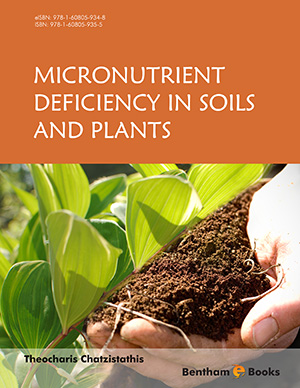Abstract
Copper is needed in very low concentrations by plants. The critical Cu deficiency level for adequate plant growth is around 2-4 p.p.m., depending on plants species and genotypes. Copper is involved in many physiological and biochemical functions, such as photosynthesis, electron transport in photosystem II (PSII), chloroplast ultrastructure, carbohydrate and nitrogen metabolism, water permeability of xylem vessels, as well as in the production of DNA and RNA; it is also related with mechanisms of disease resistance. The critical Cu concentration, according to the DTPA solution, is 0.2 p.p.m. Soil available concentrations of Cu depend on parent material, pH and CaCO3 content, organic matter, phosphoric ion content, cation exchange capacity (C.E.C.), soil type, structure and moisture, the availability of other nutrients etc. Some of the most characteristic symptoms of Cu deficiency include the formation of narrow and twisted leaves, as well as leaf curling, while their petioles bend downward. Enhanced remobilization and retranslocation in order to overcome Cu starvation and survive are within the most important mechanisms of tolerance adopted by plants. Increased antioxidant defence mechanisms under Cu stress conditions include enzymatic and non-enzymatic antioxidant responses. When crops suffer from Cu deficiency, both soil or foliar applications may be a good solution; CuSO45H2O is usually the substance that is preferred. Apart from Cu sulphate (25% Cu), other Cu sources that could be used as Cu fertilizers are: cupric oxychloride (50% Cu), cuprous oxide (32.8% Cu) and chelated Cu (5% Cu).
All these topics concerning Cu availability in soils and uptake by plants, the roles of Cu in plant metabolism, the critical concentrations and symptoms of Cu deficiency, as well as the tolerance mechanisms and strategies adopted by plants in order to survive under Cu starvation, and the Cu-fertilizers that can be used to overcome Cu deficiency in crops, are fully discussed and analyzed.
Keywords: COPT proteins, Cu availability, Cu deficiency, Cu fertilizers, Cu homeostasis, Cu sulphate, Cu tolerance , Cu uptake, cupric oxychloride.






















